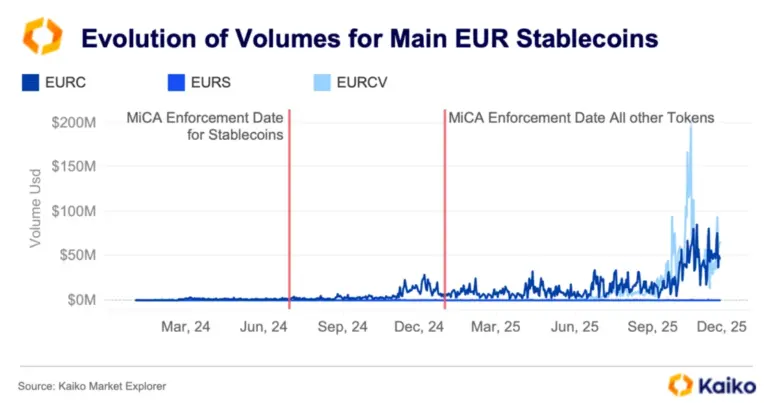Liquidity Flywheel Drives Binance to 300 Million Users

The Data Behind the SEC’s Big Week

Welcome to Deep Dive!
This has been perhaps the single most consequential week for crypto in the U.S., as the SEC charged Coinbase with operating an unregistered securities exchange and charged Binance, Binance.US, and CEO Changpeng Zhao (“CZ”) with a variety of securities law violations.
-
Binance.US’s volume has largely been generated from altcoins
-
Exchanges have begun delisting tokens
-
The SEC alleges Binance allowed wash trading
-
Binance.US’s market share has been volatile
Just two months ago, we chronicled the CFTC’s charges against Binance and CZ, which primarily focused on Binance’s alleged efforts to onboard high-volume U.S. traders onto Binance, rather than Binance.US (for simplicity, “Binance” will refer to the international exchange and “Binance.US” its U.S. affiliate).
This analysis showed that despite the creation of Binance.US in 2019, Binance’s trading had actually become more skewed towards U.S. hours, in fact resembling U.S.-based exchanges like Coinbase.
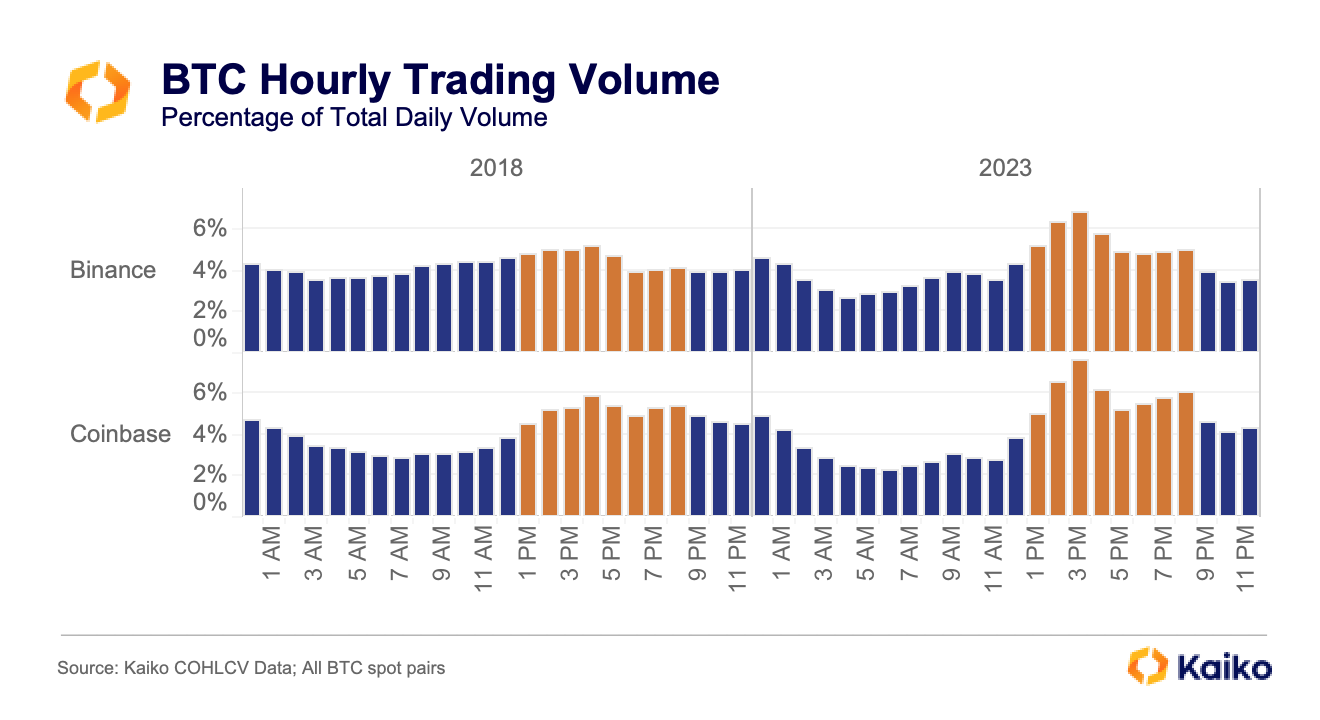
Additionally, after the CFTC charges were revealed, the share of Binance volume during U.S. hours fell from 55% to just 38%.
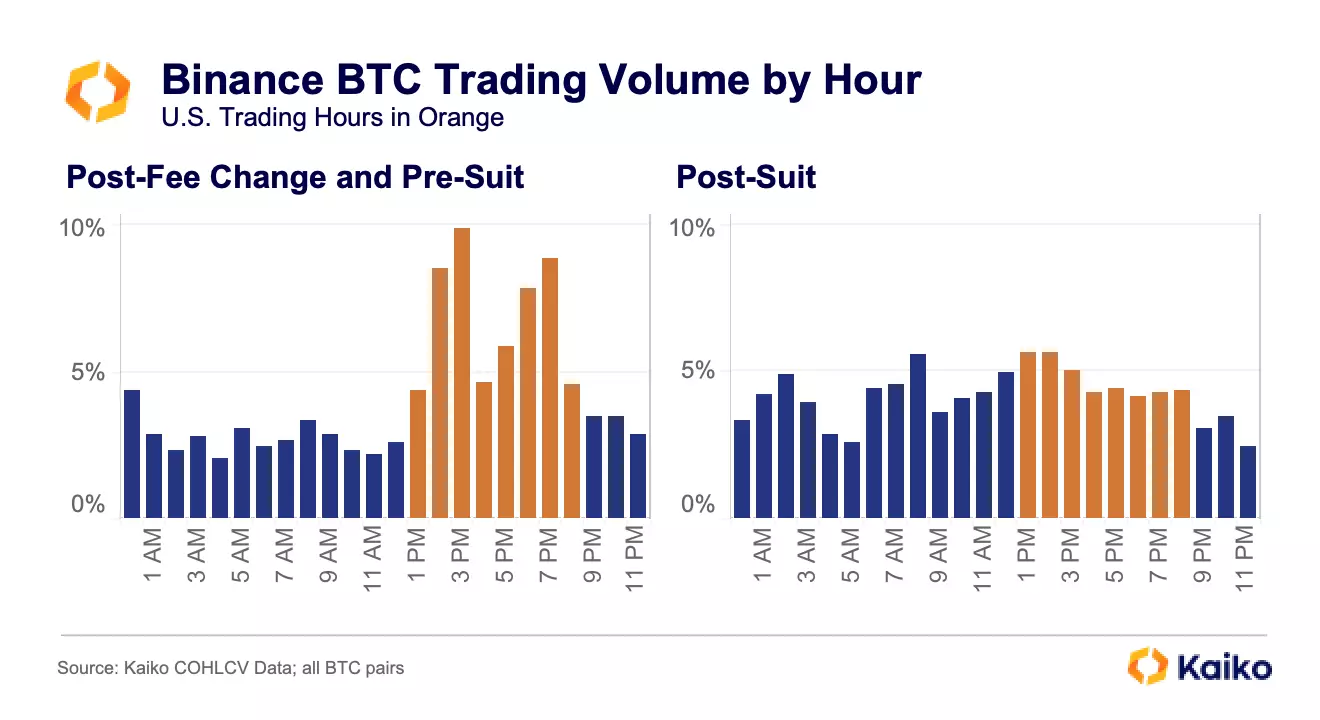
The SEC’s allegations restate the CFTC’s claims while adding some new detail, primarily focused on Binance.US and CZ’s other business entities. Meanwhile, the charges against Coinbase are entirely new. This week we’ll lay out the allegations in each suit and then examine the data to provide more context.
Never miss an analysis.
Subscribe to our free weekly Data Debrief email, or learn more about our premium research subscriptions here.
Here are the allegations:
Binance
- Leadership solicited U.S. investors to trade on Binance.
- In March 2020 U.S. VIPs accounted for 70% of global VIP volume, in May 2021 this was 63%.
- Binance acts as an unregistered exchange, broker and dealer, and clearing agency.
- Binance and Binance.US engaged in unregistered offers and sales of securities, including BNB and BUSD as well as BNB Vault and Simple Earn.
- The securities identified include SOL, ADA, MATIC, FIL, ATOM, SAND, MANA, ALGO, AXS, and COTI.
- Binance and Binance.US engaged in unregistered offers and sales of securities, including BNB and BUSD as well as BNB Vault and Simple Earn.
- Binance created BAM Management and BAM Trading in the U.S. and claimed these entities independently controlled Binance.US, but CZ was actually closely involved in their operation.
- Binance.US used two market makers – Sigma Chain and Merit Peak – both of which were controlled by CZ.
- BAM did not implement trade surveillance or manipulative trading controls for Binance.US until February 2022.
- The exchange’s matching engine allowed users to trade with themselves.
- Sigma Chain – a trading firm owned by CZ – was wash trading on Binance.US from September 2019 until June 23, 2022.
Coinbase
- Coinbase acts as an unregistered broker, securities exchange, and clearing agency,
- Securities include SOL, ADA, MATIC, FIL, SAND, AXS, CHZ, FLOW, ICP, NEAR, VGX, DASH, and NEXO.
- Coinbase has listed tokens that the SEC had previously defined as securities in enforcement actions: AMP, DDX, LCX, OMG, POWR, RLY (delisted), XYO.
- Staking is also an unregistered offer and sale of securities.
- Staking is currently offered for XTZ, ATOM, ETH, ADA, SOL.
- Coinbase worked with issuers to fix “problematic statements” that could draw the ire of the SEC.
Listing unregistered securities
The actions this week were the clearest reflection yet of SEC Chairman Gary Gensler’s repeated assertion that most cryptocurrencies are securities. However, Bittrex – which filed for bankruptcy in May – was the first to be charged in this regard. When examining the active trading instruments on each exchange it’s clear why: Bittrex was by far the most aggressive U.S. exchange in terms of listing new tokens, reaching a peak of over 1,000 instruments in May 2022.
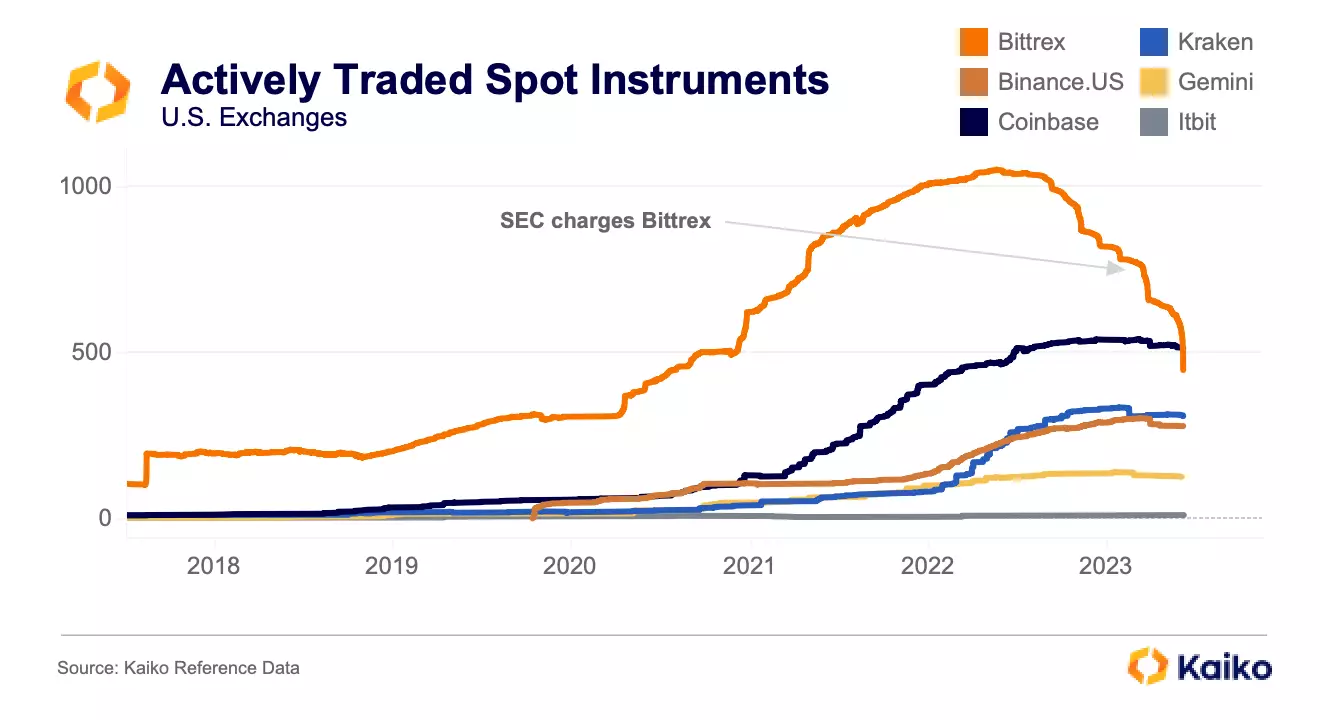
Coinbase, too, took a much more aggressive listing approach in 2021. At the start of 2021, there were 130 instruments on the exchange; a year later there were over 400. Notably, this doesn’t include the thousands of tokens that are available through Coinbase Wallet, which utilizes DEXs like Uniswap and Sushiswap. The SEC included NEXO, which is only available through Wallet, in its list of unregistered securities that Coinbase was offering [1].
Binance.US didn’t accelerate its listing until late 2021, jumping from 120 instruments to a peak of over 300 in March 2023. I’ve included some other U.S. exchanges for context, showing how Kraken was slow to list until 2022, when it began listing even faster than Binance.US. Meanwhile, itBit – the exchange operated by Paxos which is regulated in NY state – has listed just 10 active trading instruments. However, one of its listed tokens is SOL, which was identified as a security in both complaints.
Wash trading
One of the most interesting allegations is that CZ’s trading firm Sigma Chain was wash trading on Binance.US to inflate the exchange’s volumes. The complaint said that wash trading escalated during three critical periods: Binance.US’s launch in September 2019, when new tokens were listed, and the lead up to seed funding in September 2021. The complaint further quotes a Binance executive who said that Sigma Chain represented up to 50% of Binance.US’s volume at times.
From Q4 2020 to Q1 2021, Binance.US’s altcoin volume exploded from $2.6bn to $30.5bn. The next quarter it hit $82bn, with just $12.5bn BTC and $11bn ETH volume. It’s worth noting how unusual this is: virtually no exchanges outside of Korea have altcoin volume that is higher than BTC and ETH volume combined, and certainly not for such an extended period of time.
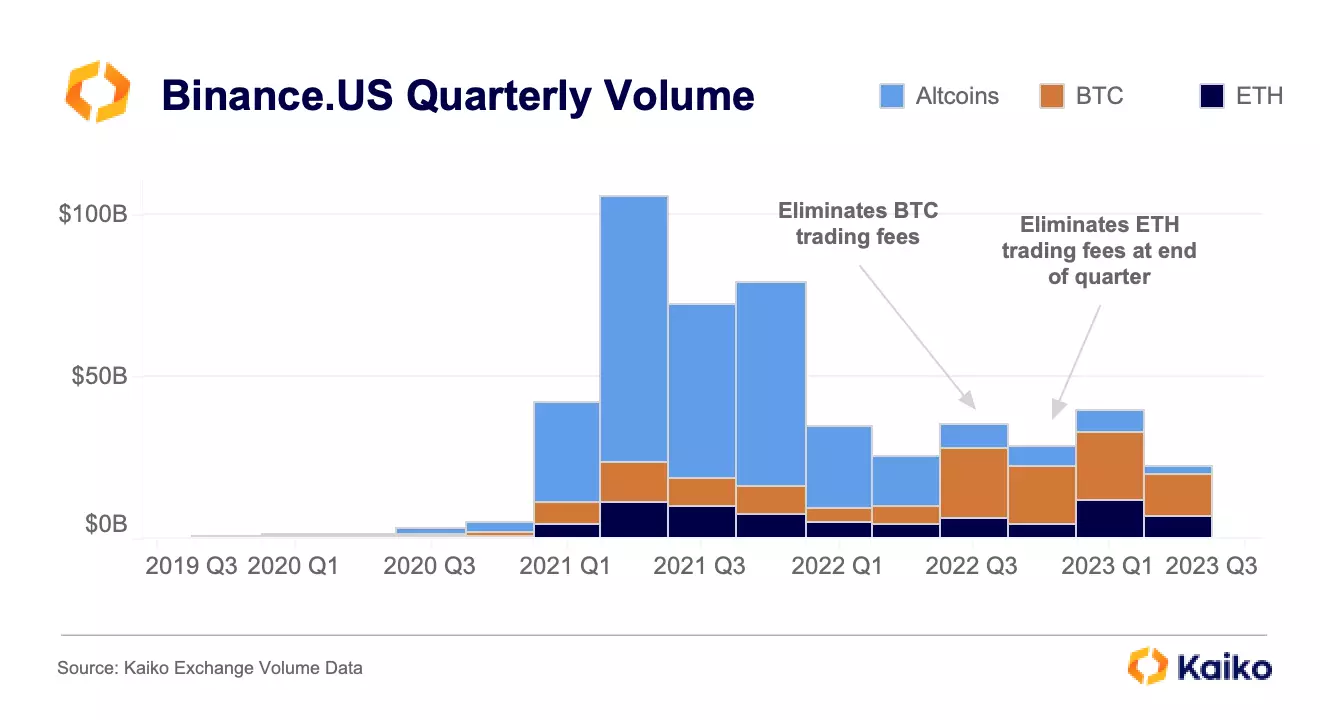
Altcoin volume dropped quickly in 2022, shrinking to just $7bn in Q3 2022. That same quarter, Binance.US eliminated fees on BTC trading, which helped boost volumes from $6bn to $22bn. At the end of the next quarter it eliminated ETH trading fees, boosting volumes from $4bn to $12bn.
The bull market began in Q4 2021, which could help explain why the exchange’s volumes skyrocketed the following quarter. However, exchange market share tells a different story.
Below is charted altcoin volume market share amongst U.S. exchanges. BTC and ETH are excluded to eliminate the noise associated with the aforementioned fee changes.
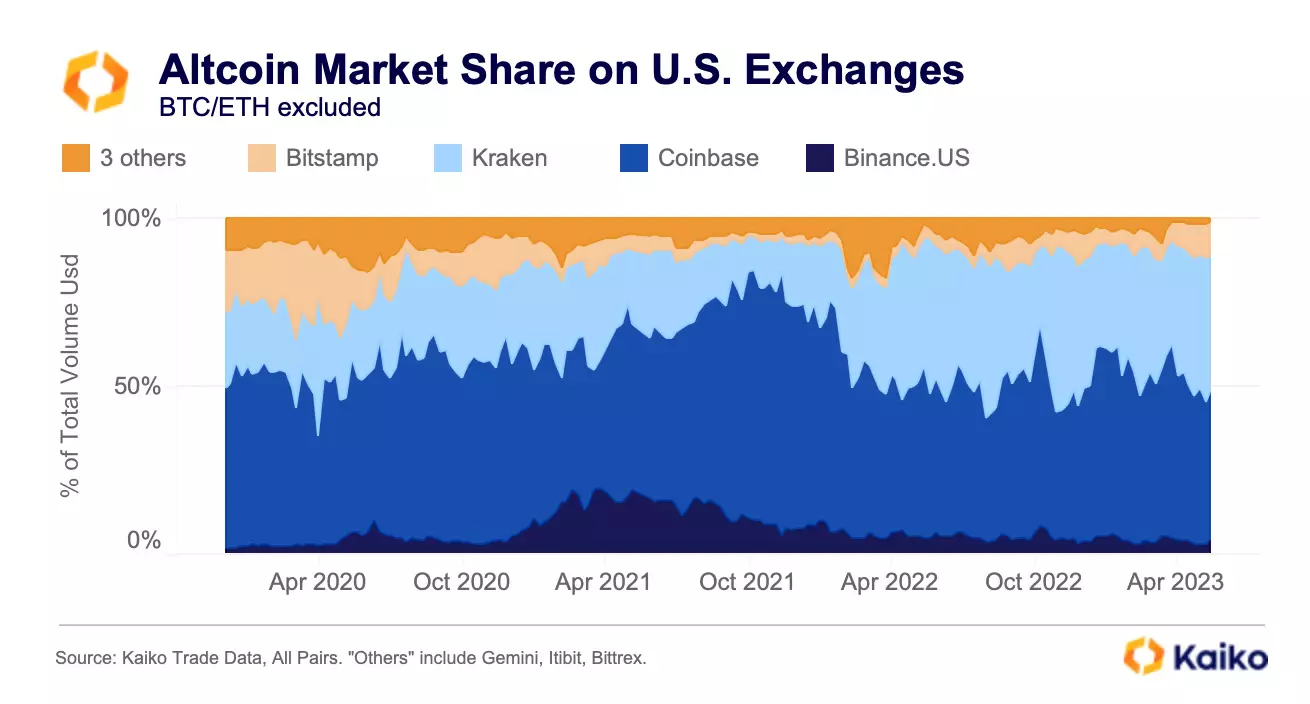
Beginning in 2021, Binance.US quickly surged to a near 25% market share in the spring, then remained there until the fall, declining from September until December before rising slightly again in early 2022. The SEC’s most specific claim alleges wash trading before the exchange’s seed funding in September 2021.
The complaint singles out COTI, using it as an example of newly listed token wash trading, claiming that up to 35% of the token’s volume came from Sigma Chain. It’s unclear how the SEC assigned such precise figures to Sigma Chain’s alleged wash trading given that centralized trading data is anonymous, but as discussed in a previous Deep Dive, there are still ways to investigate this claim.
One of my favorite ways is to look at the hourly volume distribution. Charted below is the breakdown of hourly COTI volume in 2022 on Binance, Binance.US, and Coinbase.
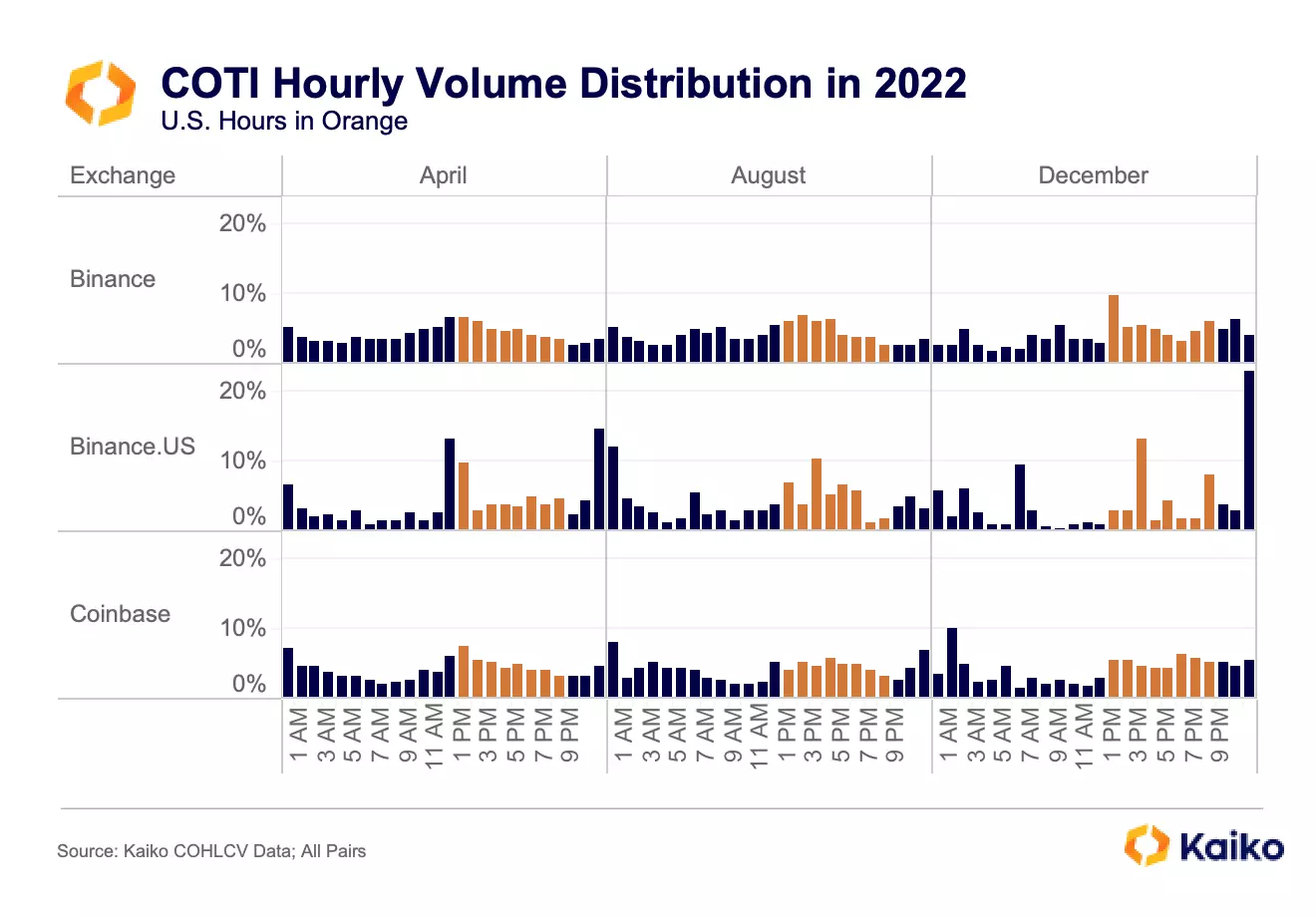
Binance and Coinbase show relatively standard volume distributions, with smooth curves that usually peak at the beginning of U.S. hours. Binance.US’s volume is incredibly irregular, with spikes in certain hours in certain months. For example, in April 2022, the hours of 8am and 7pm ET accounted for nearly 30% of volume. In December, 11am and 7pm accounted for 36% of volume.
While this does not definitively prove that there was wash trading, it does indicate that trading activity was highly unusual.
What happens next?
On Tuesday, the SEC filed an emergency action to freeze assets related to BAM Trading, the entity that controls Binance.US. Almost immediately after it announced this, BTC prices on Binance.US began to diverge from prices on other exchanges.
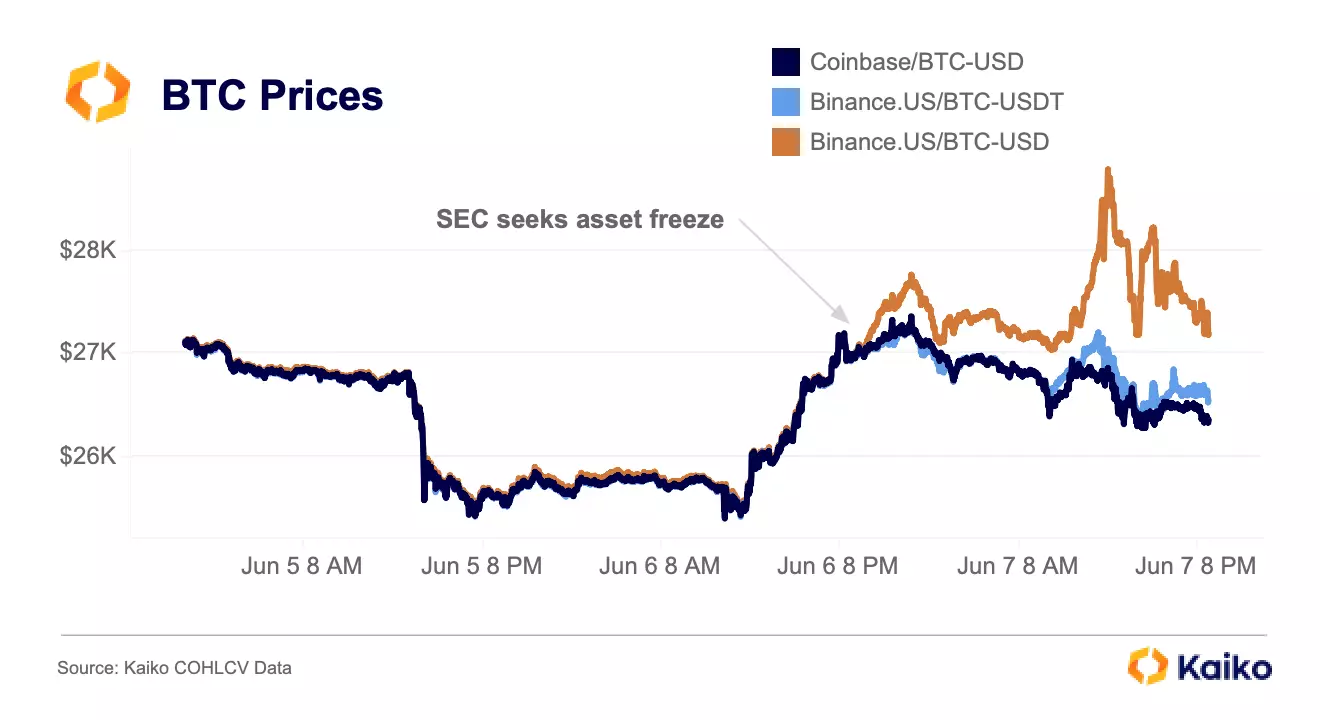
Both the BTC-USDT and BTC-USD on Binance.US diverged to the positive side as word of mouth spread that the exchange was processing BTC withdrawals faster than stablecoin or fiat withdrawals. This led users to swap into BTC in an attempt to get their funds off the exchange.
On Wednesday, Binance.US announced that it would be delisting 40 trading pairs, though the delistings notably did not include SOL, ADA, MATIC, FIL, ATOM, SAND, MANA, ALGO, or AXS. In fact, the only token flagged by the SEC that Binance.US has announced it will be delisting is COTI. The instruments being removed accounted for just $75mn of the exchange’s nearly $6bn of volume last month.
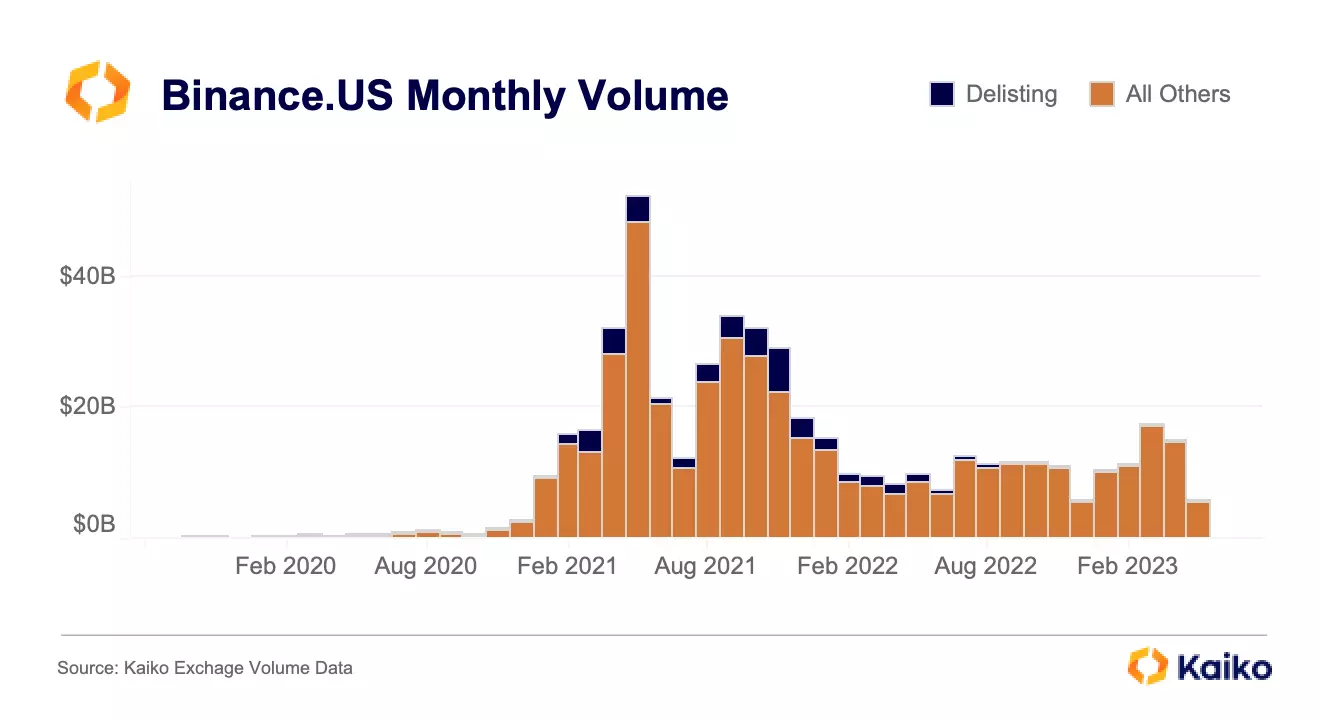
While Binance.US’s health is the most pressing concern, there are huge ramifications from this week’s regulatory actions that will continue to play out in the coming months. Thus far, the impact on liquidity has not been even across exchanges. Below is charted the aggregated 1% market depth for all tokens that the SEC has labeled a security on each relevant exchange.
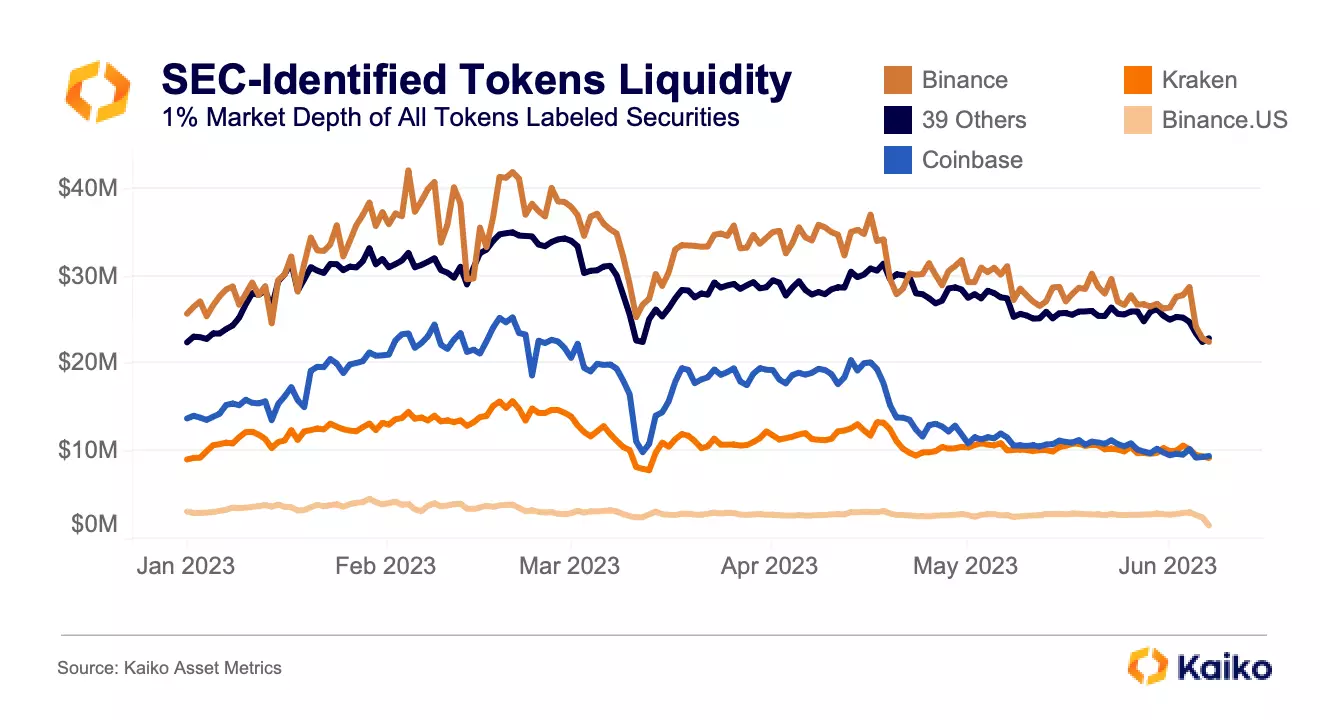
Binance’s liquidity has fallen from $30mn before the announcement to $22mn today. It has almost exactly the same amount of liquidity as the next 39 exchanges combined (minus the other exchanges charted). Coinbase, meanwhile, has been nearly unaffected by the regulatory action. However, its liquidity had previously halved back in April. The next most liquid U.S. exchange – Kraken – has also been very stable. Finally, Binance.US’s liquidity dropped from $2.75mn to $1.5mn. The stability on most exchanges is a positive sign that sophisticated market makers are not panicking because of this regulatory action.
Ultimately, if some of the allegations against Binance and Binance.US are true – such as wash trading and comingling of funds – shedding light on and rooting out these actions should be beneficial for the long-term health of the industry. When it comes to facilitating trading of unregistered securities, exchanges took a calculated risk when accelerating listings, adhering to the (in)famous Web 2.0 ethos of “moving fast and breaking things.” The exchanges will likely continue to argue that the rules of the road in the U.S. are not totally clear: which tokens are and aren’t securities?
This week marked an inflection point, with the SEC taking on two of the world’s largest exchanges. Although the resolution may take some time, regulatory clarity is on the way, one way or another.
[1] I think this is one of the most significant details in the Coinbase complaint and has not been discussed much yet. Coinbase itself never listed the token. Instead, it provided the software (Coinbase Wallet) that allowed users to trade the token on decentralized exchanges. The implications of this for DEXs and wallet providers remains to be seen.
Data Used In This Analysis

More From Kaiko Research
![]()
Derivatives
29/12/2025 Data Debrief
Santa Rallies, Cycles, and Year-End Reflections for BitcoinAs markets approach the end of the year, Bitcoin finds itself at a familiar crossroads, caught between cyclical behavior and a steadily developing market. While year-end seasonality has historically played a role in shaping price action, recent data suggests that cyclical drivers are increasingly dominant.
Written by Laurens Fraussen![]()
Derivatives
22/12/2025 Data Debrief
Crypto in 2026, What Breaks, What Scales, What ConsolidatesCrypto markets enter 2026 in a markedly different position than in prior cycle transitions. Rather than resetting after a speculative peak, the market appears to be progressing through a phase of institutional consolidation.
Written by Thomas Probst![]()
Year in Review
01/12/2025 Data Debrief
Kaiko Research's Top 10 Charts of 2025In this report, we look back on 2025 and the key forces that shaped markets. From BTC record highs and fleeting altcoin rallies to major liquidation events and evolving regulation, we examine what shaped a seminal year for crypto.Written by Adam Morgan McCarthy![]()
Stablecoin
24/11/2025 Data Debrief
MiCA's Impact on Crypto in EuropeEurope is progressing with a conservative structured crypto framework that leans towards regulating innovation.Written by Adam Morgan McCarthy







